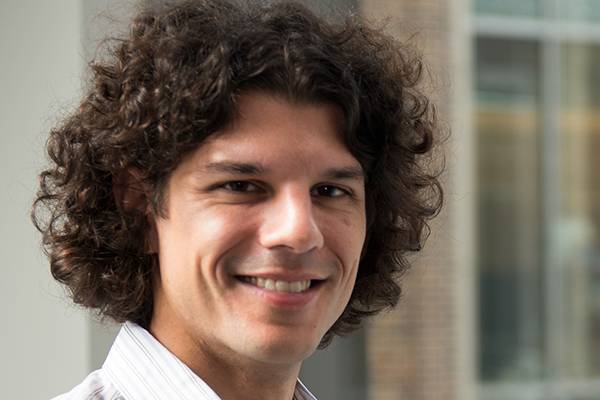Hormone Activation Of Genes Takes Teamwork
Signaling of genes more complex, nuanced than thought

The forward march of science often blunders into the realization that nature’s way of doing things is a lot more complicated than we thought.
So it is apparently with the process that activates genes to start the machinery for manufacturing proteins, according to a team of Duke scientists.
Using the latest in DNA-sequencing and computerized ‘high-throughput’ biology, the team wanted to address the difficult puzzle of why there are tens of thousands of places where the glucocorticoid receptor binds to our DNA to signal a gene to begin making proteins, but this signaling only seems to govern the levels of a few hundred genes.
They wondered why there would be so many receptor sites for so little apparent action and why these sites seem to be organized in clusters around the genome, rather than being more evenly distributed.
The cortisol signaling system they chose to examine is part of the human stress response, and has major biomedical significance as the basis for some of the most commonly used anti-inflammatory medications, said Tim Reddy, an assistant professor of biostatistics and bioinformatics whose lab led the project. But the team believes the kind of organization they found is common to other hormone signaling systems as well.
Using a line of cells from human lungs, “we did millions of experiments over tens of thousands of sites on the genome,” Reddy said. “We were really surprised to find that only about 13 percent of these binding sites seemed to do anything when you chopped them out of the genome and looked at them alone.”
But those 13 percent, which the researchers have called “direct-response sites,” weren’t all that potent at signaling when examined individually. And the other 87 percent of binding sites aren’t archaic leftovers or ‘junk,’ either, Reddy is quick to add. Rather, the two kinds of sites seem to act together as a sort of amplifier for the hormone signal.
In findings described online Aug. 25 in Cell, the team reports that when a direct binding site and its nearby cluster of inactive binding sites are brought together, the signal to the gene becomes as much as 100-fold stronger.
"Our hope is that learning more about how these clusters coordinate to turn on genes in different cells will help us design new drugs that only act on the cells that we want," said Duke Cell Biology graduate student Chris Vockley, who is the lead author on the study.
The team is following up now to see whether different kinds of cells are marked by differences in these clusters of indirect response sites. Such variation may explain why various tissues respond differently to a given stimulus despite having the same set of genes and essentially the same set of direct-response binding sites.
After puzzling over it for a while, Reddy came up with an analogy for this organization of binding sites while out on a run with his wife: If the cell is like a house, these direct-action sites are sort of like the electrical outlets in the walls, he said.
”These are the places in the genome that directly respond to a hormone,” Reddy said. “The appliances in the house end up clustered around these outlets because the cords are only so long, just as we see indirect sites clustered around direct sites in the genome.”
And if one family moves out of the house, and another moves in -- representing a cell of a different tissue type -- the appliances may be plugged in with a different configuration. “The outlets don’t change, but the appliances do.”
“It really seems like at the core of these clusters, there might be one or a small number of sites that are really the main ‘electrical outlet’ that everything can plug into and everything else can kind of loop in,” Reddy said.
“It doesn’t surprise me that it’s more complicated than some people hoped it would be,” said Mike Guertin, an assistant professor biochemistry and molecular genetics at the University of Virginia, who was not involved in this study.
“The most important thing to me is that this paper shows that glucocorticoid receptors don’t -- at least in this system -- act to directly repress gene expression,” Guertin said, which would overturn a widely-held belief.
These findings also make clear that scientists searching for the keys to gene regulation have a ton of complicated work ahead of them.
“The field is pretty nascent,” Guertin said. “We’ve only been able to look at whole-genome questions like this since about 2007. I think we have a lot of opportunities to design clever, hypothesis-driven experiments like this, instead of just generating data.”
Reddy is undaunted. “If the genome is no longer a bunch of independent sites that kind of add up to some response, but instead has interactions between all these sites, we either have to fundamentally change how we’re modeling the whole genome -- which is a huge thing – or it means that we need to start thinking about these groups of sites, understanding why genes are regulated and why disruption of that regulation can cause disease.”
This project was supported by several grants from the National Institutes of Health.
CITATION: “Direct GR Binding Sites Potentiate Clusters of TF Binding Across the Human Genome,” Christopher Vockley, Anthony D’Ippolito, Ian McDowell, William Majoros, Alexias Safi, Lingyun Song, Gregory Crawford, Timothy Reddy. Cell, Sept. 8, 2016. DOI: 10.1016/j.cell.2016.07.049